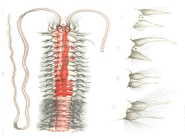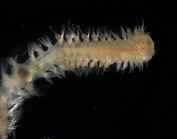
| About | | Search taxa | | Taxon tree | | Search literature | | Checklist | | Stats | | Log in |
WoRMS taxon detailsPoecilochaetus serpens Allen, 1904
130711 (urn:lsid:marinespecies.org:taxname:130711)
accepted
Species
marine,
recent only
Allen, Edgar Johnson. (1904). The anatomy of <i>Poecilochaetus</i>, Claparède. <em>The Quarterly Journal of Microscopical Science, London. New Series.</em> 48(189): 79-151, plates 7-12., available online at https://doi.org/10.1242/jcs.s2-48.189.79
page(s): 81-140, 145, plates 7-12 [details]
Holotype , geounit English Channel
Holotype, geounit English Channel [details]
Etymology Allen (1904:82) "I propose for the species of Poecilochaetus found at Plymouth and described in this paper, the name...
Etymology Allen (1904:82) "I propose for the species of Poecilochaetus found at Plymouth and described in this paper, the name Poecilochaetus serpens, the specific name being selected to indicate the rapid, wriggling movement both of the larva and of the adult worm when swimming." [details] Description An elongated, cylindrical body up to 55mm long with a small, spherical head surrounded by long tentacles. The first...
Description An elongated, cylindrical body up to 55mm long with a small, spherical head surrounded by long tentacles. The first segments are directed forward and bear long hair-like bristles. The shape of the parapodial flaps depends on their location on the body. The colour ranges from red (anterior end) over dark green to black with white patches (posterior end). Digs U-shaped burrows. [details] Distribution Poecilochaetus serpens was in both periods found across the Flemish, Zeeland and Hinder Banks as well as across the western...
Distribution Poecilochaetus serpens was in both periods found across the Flemish, Zeeland and Hinder Banks as well as across the western coastal zone. However, the relative frequency of occurrence in both periods was low. Poecilochaetus serpens reached densities up to 300 ind./m2 (1994-2001 period). [details]
Read, G.; Fauchald, K. (Ed.) (2025). World Polychaeta Database. Poecilochaetus serpens Allen, 1904. Accessed through: World Register of Marine Species at: https://www.marinespecies.org/aphia.php?p=taxdetails&id=130711 on 2025-07-17
Date action by
Nomenclatureoriginal description
Allen, Edgar Johnson. (1904). The anatomy of <i>Poecilochaetus</i>, Claparède. <em>The Quarterly Journal of Microscopical Science, London. New Series.</em> 48(189): 79-151, plates 7-12., available online at https://doi.org/10.1242/jcs.s2-48.189.79 page(s): 81-140, 145, plates 7-12 [details] basis of record Bellan, G. (2001). Polychaeta, <i>in</i>: Costello, M.J. <i>et al.</i> (Ed.) (2001). European register of marine species: a check-list of the marine species in Europe and a bibliography of guides to their identification. <em>Collection Patrimoines Naturels.</em> 50: 214-231. (look up in IMIS) [details] Taxonomyredescription
Jirkov, I.A. (2001). [Polychaeta of the Arctic Ocean] (In Russian) Polikhety severnogo Ledovitogo Okeana. Yanus-K Press, Moscow, 632 pp., available online at https://www.researchgate.net/publication/259865957_Jirkov_2001_Polychaeta_of_the_North_Polar_Basin [details] Available for editors Othercontext source (Deepsea)
Intergovernmental Oceanographic Commission (IOC) of UNESCO. The Ocean Biogeographic Information System (OBIS), available online at http://www.iobis.org/ [details]
context source (HKRMS) BU. (2013). Provision of services for field sampling, species identification and data analysis of benthic faunal communities of Hong Kong marin waters. Final report submitted to EPD. [details] context source (Schelde) Maris, T., O. Beauchard, S. Van Damme, E. Van den Bergh, S. Wijnhoven & P. Meire. (2013). Referentiematrices en Ecotoopoppervlaktes Annex bij de Evaluatiemethodiek Schelde-estuarium Studie naar “Ecotoopoppervlaktes en intactness index”. [Reference matrices and Ecotope areas Annex to the Evaluation methodology Scheldt estuary Study on “Ecotope areas and intactness index”. <em>Monitor Taskforce Publication Series, 2013-01. NIOZ: Yerseke.</em> 35 pp. (look up in IMIS) [details] context source (BeRMS 2020) Bio-environmental research group; Institute of Agricultural and Fisheries research (ILVO), Belgium; (2015): Macrobenthos monitoring in function of the Water Framework Directive in the period 2007-2009. [details] context source (Bermuda) Sterrer, W. (1986). Marine fauna and flora of Bermuda: a systematic guide to the identification of marine organisms. <em>Wiley-Interscience Publication. Wiley.</em> 742 pp (Nemertini part). [details] Available for editors additional source Day, J. H. (1967). [Sedentaria] A monograph on the Polychaeta of Southern Africa. Part 2. Sedentaria. British Museum (Natural History), London. pp. 459–842., available online at http://www.biodiversitylibrary.org/bibliography/8596 [details] additional source Muller, Y. (2004). Faune et flore du littoral du Nord, du Pas-de-Calais et de la Belgique: inventaire. [Coastal fauna and flora of the Nord, Pas-de-Calais and Belgium: inventory]. <em>Commission Régionale de Biologie Région Nord Pas-de-Calais: France.</em> 307 pp., available online at http://www.vliz.be/imisdocs/publications/145561.pdf [details] additional source Hartmann-Schröder, G. (1996). Annelida, Borstenwürmer, Polychaeta [Annelida, bristleworms, Polychaeta]. <em>2nd revised ed. The fauna of Germany and adjacent seas with their characteristics and ecology, 58. Gustav Fischer: Jena, Germany. ISBN 3-437-35038-2.</em> 648 pp. (look up in IMIS) [details] Available for editors additional source Liu, J.Y. [Ruiyu] (ed.). (2008). Checklist of marine biota of China seas. <em>China Science Press.</em> 1267 pp. (look up in IMIS) [details] Available for editors  Present Present  Present in aphia/obis/gbif/idigbio Present in aphia/obis/gbif/idigbio  Inaccurate Inaccurate  Introduced: alien Introduced: alien  Containing type locality Containing type locality
Holotype, geounit English Channel [details]
From editor or global species database
Etymology Allen (1904:82) "I propose for the species of Poecilochaetus found at Plymouth and described in this paper, the name Poecilochaetus serpens, the specific name being selected to indicate the rapid, wriggling movement both of the larva and of the adult worm when swimming." [details]Unreviewed
Description An elongated, cylindrical body up to 55mm long with a small, spherical head surrounded by long tentacles. The first segments are directed forward and bear long hair-like bristles. The shape of the parapodial flaps depends on their location on the body. The colour ranges from red (anterior end) over dark green to black with white patches (posterior end). Digs U-shaped burrows. [details]Distribution Poecilochaetus serpens was in both periods found across the Flemish, Zeeland and Hinder Banks as well as across the western coastal zone. However, the relative frequency of occurrence in both periods was low. Poecilochaetus serpens reached densities up to 300 ind./m2 (1994-2001 period). [details] Habitat Known from seamounts and knolls [details] Habitat Poecilochaetus serpens is found in sediments with a median grain size between 150 and 550 μm. The species does not tend to have a clear preference and never reaches a relative occurrence exceeding 20%. Contrary to the median grain size, the mud content does play a decisive role in the habitat preference: Poecilochaetus serpens prefers sediments with low mud contents (maximum 30%). [details] |


